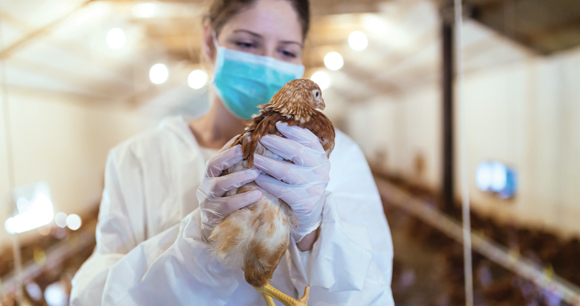Major natural disasters and public health emergencies, such as the COVID-19 pandemic, have the potential to impact farm animal welfare in many ways. For example, illness among farm workers can significantly compromise a farm’s ability to provide animal care. Moreover, veterinarians may be making fewer calls to diagnose, treat, and in some cases euthanize sick or injured animals on the farm.

Another consequence of major emergencies is less oversight of the treatment of farm animals. During the COVID-19 shutdown, quality assurance and third-party food certification programs have postponed or cancelled many of their on-farm animal care audits. It is also likely that official investigations of animal neglect and cruelty complaints have been delayed.
Consumer behavior also affects farm animal welfare. Concern about supply disruptions has led to panic buying of certain staples, including meat and eggs. Some consumers are attempting to start from scratch: Feed stores have reported selling out of baby chicks. Many such purchasers will no doubt lack the knowledge or facilities to provide proper care.
Intensively raised farm animals must be provided a consistent supply of feed, which depends on the availability of truck drivers. And even before the pandemic, the United States was experiencing a serious shortage of livestock haulers. Illness among drivers can result in delays in animals reaching their destination, or truckloads of animals being abandoned during transport.
At the slaughterhouse, illness among government inspectors may reduce oversight of the federal humane slaughter regulations, potentially leading to an increase in animal cruelty incidents. Meanwhile, worker walkouts to protest lack of safety equipment and/or disease outbreaks affecting thousands have resulted in the shuttering of a number of major slaughter establishments. Under these circumstances, animals may be held for extended periods on plant premises without proper care or subjected to additional transport—either back to the farm or to another slaughterhouse.
Early in the COVID-19 outbreak, some pigs never made it to market and were killed and disposed of on the farm, but the killing method used may have been less humane than at the slaughterhouse. When slaughter capacity is reduced, breeding animals at the end of their productive lives (dairy and beef cows, bulls, and sows) must be held on the farm longer, putting additional stress on already depleted animal care resources and extending the suffering of these animals whose health is often compromised by lameness or other disease conditions.
One US poultry company “depopulated” 2 million healthy chickens because a shortage of slaughterhouse workers due to illness left it unable to conduct slaughter and processing operations. The killing method was not disclosed. Delaying slaughter would have raised other issues—meat chickens grow at a very rapid rate and, at market weight, are prone to skeletal and heart problems. For this reason, the birds would have experienced pain and distress if they had been allowed to live longer and grow even bigger, with presumably less attention to their care.
Farm animals often suffer immensely during national disasters. While disaster preparedness efforts would no doubt mitigate some of the negative consequences of emergencies, as long as massive numbers of farm animals are raised under intensive systems that rely on complex resource chains that are subject to breakdowns during disasters, farm animal suffering is probably inevitable.